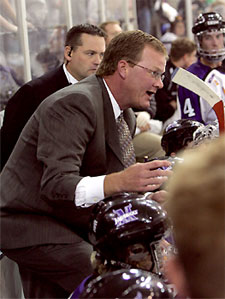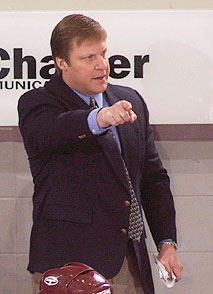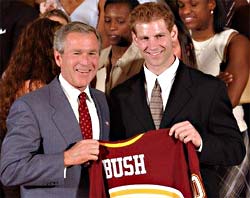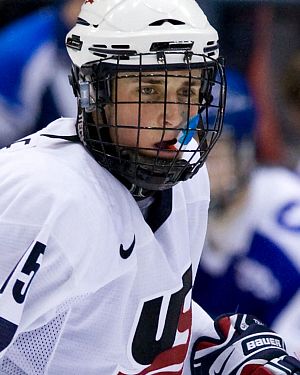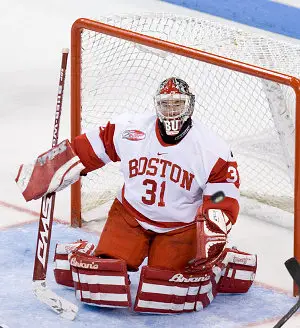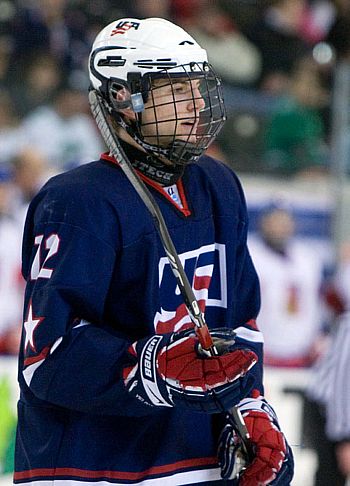In a dimly lit ballroom, a light shines down on some very well known people who are surrounded by reporters, video cameras and photographers snapping hundreds of photos.
These stylish looking people in suits are in the spotlight, both literally and figuratively, but no, it’s not a movie premier with popular actors and paparazzi, it’s a media event in Montreal with this year’s top 12 prospects for the 2009 NHL Entry Draft.
Eighteen-year-old Jordan Schroeder, who is going into his sophomore year at Minnesota, is one of the highly touted players attracting attention from pro scouts, coaches and international media.
This 5-foot-8 Minnesota native had a highly successful freshman campaign with the Gophers in which he nabbed the WCHA rookie of the year award. He was the only college hockey freshman in the country to be in the top 50 in scoring, finishing second on the team with 45 points and fourth in the NCAA with a 1.3 points-per-game average.
Minnesota coach Don Lucia gave insight as to why Schroeder is such an elite player.
“Well, he sees the ice extremely well and he’s a tremendous passer,” Lucia said. “He was our No. 1 center as an 18-year-old playing against other people’s No. 1s for most of the year — actually I should say all year. We used him in every situation — in penalty killing, on the power play, 4-on-4, so as a forward he couldn’t have played any more than he did for us.”
What separated Schroeder from the rest of his class is that he came in with confidence and never got star struck.
“What helped him was his background playing at a higher level at such young ages,” Lucia said. “He was in a position — I mean he had played on the World Junior team the year before — that he could walk in and wasn’t going to be intimidated or awed by any setting he was going to see. He obviously has high expectations of himself; he’s an elite player. He was comfortable from day one in his role.”
Schroeder may be a lock in for being selected in the first round of the draft, but his superstar abilities did not just appear like a special effect in a Hollywood movie, he worked from the bottom up.
Jordan’s mother Deb explained that her son jumped into the sport when he was about 4 years old and hasn’t looked back since.
“We took him to Burnsville where they had open public skating and he just kind of took off,” she said. “He took a couple of falls but got back up and went back. Then we put him in skating lessons to make sure he was a good skater and they just kept moving him up in the skating classes and he just took off.
“He was playing baseball too, but you could tell hockey stood out because he always practiced on his own; he’d do the shooting in the driveway, practice with his [younger] brother. And the neighborhood we lived in there were 60 kids, and 40 were boys so they’d all play street hockey. So that’s kind of how he got into it, the older boys let him play.
“You could tell he just had the passion for it; he never complained about practices or games, always practiced on his own. And a lot of times there would be 5:30 a.m. ice and he’d be like, ‘I love going on the ice even early in the morning.’ And I said, ‘What? Most kids don’t want to get up at that time.’ But I love taking the kids to wherever because if they love something, I like to make it work. Maybe 5 a.m. was a little early for me, but it was worth it.”
Stardom knocked at Schroeder’s door prior to attending Minnesota. From 2005 to 2006 in high school at St. Thomas Academy, Schroeder aided his team in winning the Class A state championship, racking up 62 points in 31 games. Deb explained how the media attention all began:
“When he was in eighth grade he played for St.Thomas Academy and they have a high school hockey tournament up there, which is a really big deal in Minnesota,” she said. “So the first time he got like five points in the game and then all of a sudden his picture was in the paper and he was doing lots of interviews. Then the next year they won the state title, so he’s done a lot of publicity things very early on.”
This self-proclaimed selfless, hardworking guy went on to play for the U.S. Under-18 National Development Program for two years where he led the team in scoring in the 2007-08 campaign with 53 points in 55 games. The hockey world has a significant impact on families, requiring a lot of dedication and sacrifices, but it was the move to Michigan that marked a change in the Schroeder family, especially for Deb because her oldest son was leaving home.
“When he went out to Ann Arbor for the USA program when he was 15 going on 16 and it was really hard that September when he left,” she said. “His dream was to go there; he knew what he had to do to get there, and there was never a question in his mind after we went out there and looked at it. But then when he came back and committed to the University of Minnesota, selfishly I was glad he came back even though I had told him to look at a few other schools, but that’s where he wanted to be.”
Schroeder has been given a good chunk of publicity over the past few years, and just as fans love to hear the latest news about their favorite celebs, most of the hockey world wants to know whether Schroeder would walk away from college early if he had the chance to turn pro.
“Well, it would be great to go back and develop some more at the U, but if a team wants me to leave then I’m not going to say no,” Schroeder said. “I am open to options and would discuss it with my family to decide what’s best for me. So we’ll just have to wait and see.”
Schroeder has the swagger of a star off the ice as well, claiming himself to be “best dressed” on his team because he’s in fashion, he needs a cell phone at all times, he has a high-end palate for sushi and yes, he even signs autographs.
“Yeah, signing autographs is pretty cool,” he said. “I got a lot of attention, but it’s always been like that, so you got to take a step back, stay humble and try to realize this is only the beginning. I still have to get a lot better and there’s much more to come to get to the next level so I definitely have a lot of work to do.”
He’s never been to Hollywood, and may not have a star on that famous boulevard, but Jordan Schroeder is surely headed down that walk of fame.
